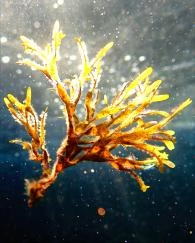Kelp, with its tender, smooth texture, is a favorite ingredient in soups and stews. When eating kelp, have you ever wondered why it’s tied in knots? Are kelp and kombu the same thing?
Why is kelp tied in knots?
Kelp knots may look a bit fancy, but are they really just for aesthetic reasons?
Kelp knots serve two main purposes: to make it easier to pick up and to prevent it from sticking to the pan. After cooking, kelp becomes sticky and easily sticks to the pan. Tying knots prevents the kelp from sticking to each other or to the pan, making it easier to pick up and eat.
It’s also said that the knots are each hand-tied, each painstakingly crafted to make them easier to eat.
Are kelp and kombu the same thing?
What’s the difference between kelp and kombu? Are kelp and konbu the same species? Strictly speaking, both kelp and konbu belong to the order Laminariales in biological classification, but they are different species.
They belong to different families and genera. For example, kelp belongs to the family Laminariaceae and the genus Laminaria, while konbu belongs to the family Pterophyceae and the genus Laminaria. Therefore, strictly speaking, both are brown algae, but they are distinct species.
However, using a broader distinction, kelp and konbu are generally considered the same species, and these brown algae can be called either kelp or konbu. However, when referring to “konbu,” most people specifically refer to dried konbu, especially dried Japanese konbu.
Is the mucus and white powder on kelp and konbu truly precious?
Now, let’s talk about kelp. Kelp thrives in cool, dry waters, ideally around 15°C. The slippery surface of kelp, which requires knotting, is due to its sticky, gelatinous texture. While some may find its slippery texture unpalatable, the mucilage contains polysaccharides, which are beneficial for intestinal health and immune system health.
Sometimes, dried kelp may have a white powder on its surface. Is this safe to eat? The white powder is mannitol, a component of kelp that is released to the surface during the drying process. Mannitol has a sweet taste and contributes to the sweetness of kelp when it’s cooked.
Some people wash off the white powder and the sticky liquid that appears after soaking dried kelp before processing it. However, this removes all the good ingredients.
Next time you handle kelp, just use a paper towel to gently wipe away any dust and dirt. Don’t wash off the mucilage or gelatin; be sure to leave it on.
What nutrients does kelp contain? Is kelp actually a great source of calcium?
In addition to its mucilaginous colloids and algin, kelp is also one of the highest-quality sources of calcium. Every 100 grams contains 87 mg, making it a truly excellent calcium supplement. It’s particularly suitable for vegetarians, as kelp provides essential iodine. Even a small daily intake of kelp and other algae can help maintain thyroid hormone levels.
However, it’s not suitable for everyone. Those with hyperthyroidism or hypothyroidism should avoid kelp and other seaweeds and follow their doctor’s advice.
Knotting kelp creates a crunchy texture and texture when eaten. The practice, invented to make it easier to pick up and reduce sticking, is actually quite common knowledge.


Leave a Reply